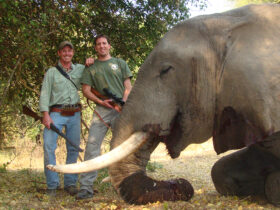
Elephant hunting is a very challenging sport. You are in for long days of tracking individual bulls or small groups of mature bull elephants. The size of the track is a good indicator of animal size and sometimes trophy size. Our experienced trackers can use the subtle aspects of the animal’s foot print to roughly determine his age and size. Elephant dung is also used to tell the age, along with the condition of the animal’s teeth. The coarser the particles in the dung, typically the older the elephants teeth may be, thus he may carry more ivory. More often than not, the day ends by turning away from the animal with the hope of finding a bigger tusker in the days to come. Even though they are the largest land animal in the world, they are difficult to see in thick brush, which is their preferred hang out. They walk silently and often the first thing you hear from them is a low rumble or the breaking of branches as they feed.
Elephants can cover great distances, so have a comfortable pair of boots. A hunter must know the position of the vitals and brain from multiple angles. A poorly placed shot from even the largest guns will have a negligible effect on the animal. I recommend a .400 caliber with good solids for elephant hunting. The killing shots are close, so open sights or a low power scope is preferred. These are not the same animal that your kids feed peanuts to at the circus – these things are big and don’t like people. Elephant in some areas are very aggressive toward people and several are killed every year as problem animals. On the hunt it is not uncommon to be charged. Most of the charges will be a mock charge. The animal will have its ears fanned out, trumpeting loudly, and breaking brush as it heads toward us. This is a very effective display of dominance.
A real charge is often silent with the ears pinned against their head. Hunters are killed by elephant every year. Trophy size is assessed by the weight of the tusks. Ivory size is genetically determined and varies throughout Africa, some places produce long thin ivory while other locations produce short and thick ivory. Estimating the exact weight of ivory is difficult due the unknown size of the hollow nerve running inside the tusk. Elephant hunting is regulated by the country. CITIES regulated the import and export of elephant trophies. Tanzania and Botswana host the best elephant hunting available to American Clients. Elephant hunts are a minimum of 10 days up to 25 days.
General Elephant Information
- Average lifespan in the wild: Up to 70 years, 50 years is old in the wild
- Size: Height at the shoulder, 8.2 to 13 ft. (2.5 to 4 m)
- Weight: 5,000 to 14,000 lbs. (2,268 to 6,350 kg)
- African elephants are the largest land animals on Earth. They are slightly larger than their Asian cousins and can be identified by their larger ears that look somewhat like the continent of Africa. (Asian elephants have smaller, rounded ears.). Elephant ears help to radiate the animal’s body heat and keep these large animals cool. Elephants are fond of water and frequent water sources. They are able to swim.
- An elephant’s trunk is actually a long nose used for smelling, breathing, trumpeting, drinking, and also for grabbing things. The trunk alone contains thousands of different muscles. African elephants have two fingerlike features on the end of their trunk that they can use to grab small items (Asian elephants have one).
- Both male and female African elephants have tusks they use to dig for food and water and strip bark from trees. Males use the tusks to battle one another. Some elephant can be tuskless. Females are smaller in overall size and size of tusks. The tusks grow throughout the animal’s life. The animals can live as long as an average human, but unlike us they will die when their teeth wear out. Elephants have 6 sets of molars that replace each other throughout their life.
- Because ivory is valuable to some humans, many elephants have been killed for their tusks. This type of killing is not hunting it is poaching. A strong distinction should be made between hunting and poaching. Trade in illegal ivory is obviously banned worldwide, but it has not been completely eliminated, and some African elephant populations remain endangered by poachers and the black market trade in ivory. All elephant that are hunted are pursued with the blessing of the country we are hunting in and all relevant licenses have been issued by the government in accordance with their management plan. We hunt mature males. The money brought to rural Africa through the legal hunting of mature elephants helps to fund anti-poaching teams and preserve the land to ensure the long term success of the species. Poaching is relatively under control in most parts of Africa, human sprawl and habitat destruction is not. This is the real enemy when it comes to the preservation of our natural resources. Money from hunters fund the preservation of the few remaining wild places on earth. We are interested in the long term preservation of all animals especially the mega fauna such as the African elephant.
- Elephants eat roots, grasses, fruit, and bark, and they eat a lot of these things. An adult elephant can consume up to 300 pounds (136 kilograms) of food in a single day.
These hungry animals do not sleep much, and they roam over great distances while foraging for the large quantities of food that they require to sustain their massive bodies.- Female elephants (cows) live in family herds with their young, but adult males (bulls) tend to roam on their own. The young males are pushed out of the herd soon after reaching sexual maturity. Under most circumstances they will not be allowed to breed until they are older. Their teenage years are spent with other sub adult males in bachelor herds or with an older dominant male. The female will stay with the herd for their entire life.






























